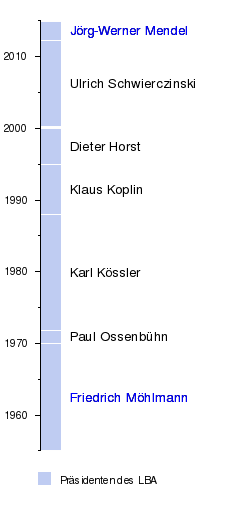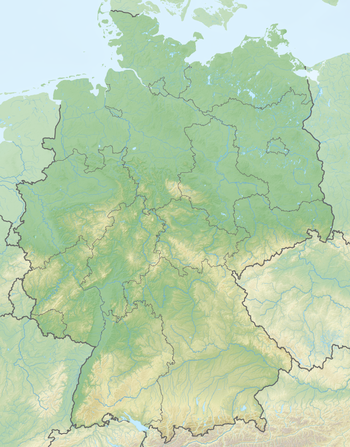Federal Aviation Office
Coordinates: 52 ° 18 ′ 53 ″ N , 10 ° 32 ′ 56 ″ E
|
Federal Aviation Office |
|
|---|---|
| State level | Federation |
| position | Higher federal authority |
| Supervisory authority | Federal Ministry of Transport and Digital Infrastructure |
| founding | February 1, 1955 |
| Headquarters | Braunschweig |
| Authority management | Jörg-Werner Mendel |
| Servants | 1052 |
| Budget volume | EUR 93.5 million (2019) |
| Web presence | www.lba.de |

The Luftfahrt-Bundesamt ( LBA ) in Braunschweig is the higher federal authority for the tasks of civil aviation in Germany. It is subject to the service and technical supervision of the Federal Ministry of Transport and Digital Infrastructure (BMVI).
history
On September 15, 1953, the "Provisional Federal Agency for Aviation Equipment and Aircraft Accident Investigation" (VBL) was established with its seat in Bonn . Her responsibilities included the management of the aircraft accident service and the search and rescue service as well as the processing of new technical regulations for the construction and testing of aviation equipment.
With the law on the Federal Aviation Office of November 30, 1954, the VBL was replaced by the Federal Aviation Office (LBA). It received its headquarters in Braunschweig and started its service on February 1, 1955 with 28 employees. Federal Transport Minister Hans-Christoph Seebohm appointed aviation engineer Friedrich Möhlmann as the first head of the LBA , who held the office until December 31, 1969. In the period that followed, the LBA experienced a continuous increase in importance and competence as it was assigned numerous tasks that were originally the responsibility of the Federal Ministry of Transport or the states.
Aircraft Accident Investigation Board (FUS)
Until 1980, aircraft accidents were investigated by the Aircraft Accident Investigation Board (FUS), which existed as an independent department within the structure of the LBA. In 1980 it was outsourced and subordinated directly to the Federal Ministry of Transport, initially continued to be administrated by the LBA. On September 1, 1998, the FUS was merged into the newly founded Federal Aircraft Accident Investigation Agency (BFU), which is also based in Braunschweig.
criticism
In response to the accident involving Germanwings flight 9525 , it became known that the EU Commission had been reprimanding the Federal Aviation Office for a number of years for a lack of qualified personnel, particularly with a view to medical fitness tests of pilots, and had demanded that these deficiencies be remedied.
tasks

The LBA is primarily a technical testing and approval authority , but it also has more extensive powers as a supervisory authority . Section 2 of the Law on the Federal Aviation Office (LFBAG) contains a comprehensive catalog of tasks. After that, the LBA will deal with:
- the approval of aircraft (e.g. airplanes , helicopters , balloons and airships ) together with the issuing of aircraft registration numbers
- the approval and supervision of aviation companies , ie maintenance and manufacturing companies and their staff
- the approval and supervision of air carriers , ie airlines and their personnel
- the training, testing and licensing of aviation personnel such as pilots , dispatchers (flight service advisors), aviation doctors or air traffic controllers
- work sharing with the German air traffic control the issuing of legal ordinances and procedures.
According to a publication by the Luftfahrt-Bundesamt on March 1, 2019, the number of aircraft registered for traffic in Germany was 21,064 aircraft in 2018, which is an increase of 33.6% compared to the 1988 base of 15,770 aircraft.
According to Section 2, Paragraph 2 of the LBA Act, the Federal Ministry of Transport and Digital Infrastructure (BMVI) can also assign other tasks to the LBA, which it has made use of and has expanded the scope of duties of the Federal Office through numerous decrees and ordinances. The LBA is also increasingly performing administrative tasks and is involved in drafting legislative proposals.
Supervision of aircraft and holders of German licenses
If the LBA learns of deficiencies in an aircraft after it has been approved, it can issue “airworthiness instructions” ( Section 29 of the Aviation Act, LuftVG). The LBA also collects and manages aeronautical files. These include the aircraft register ( Section 64 LuftVG), the central air driver file ( Section 65 LuftVG), the aviation suitability file ( Section 66 LuftVG), the file of air traffic control license and authorization holders ( Section 67 LuftVG) and the offenses register ( Section 68 LuftVG ). In addition, the LBA has the legal and technical supervision of the aviation associations commissioned according to § 31c LuftVG and is also authorized to prosecute administrative offenses in this area.
Task force
The "Task Force" of the LBA was created by a decree of May 31, 1996, by which the LBA for the issuing of entry permits and operating permits to foreign airlines, for the issuing of airline permits to German airlines and for the granting of access to Routes of intra-Community air traffic is entrusted to German and foreign air carriers. The trigger was the crash of Birgenair flight 301 in February 1996; the task force carries out random flight operations and technical safety checks on aircraft. This should lead to the internationally binding safety standards being observed. If there are deficiencies, the permits of foreign airlines can also be revoked or immediate flight bans issued. In such a case, the European Commission is also informed, which then enters a complained airline in the "list of airlines against which an operating ban has been issued in the EU" (known as the "black list").
From its inception in 1996 to 2005, around 8,000 aircraft were inspected.
Joint Aviation Requirements
As a founding member of the Joint Aviation Authorities , the LBA is responsible, among other things, for the national implementation of the Joint Aviation Requirements in German law.
organization
| 2001 | 2002 | 2003 | 2004 | 2005 | 2006 | 2007 | 2008 | 2009 | 2010 | 2011 |
| 403.5 | 405 | 409 | 406.5 | 399.5 | 384.5 | 383 | 383 | 387.5 | 389 | 384.5 |
Offices of the Luftfahrt-Bundesamt with headquarters (red), branch offices (gray) and the LBA-FS department (yellow). |
The LBA is based in the Braunschweig district of Waggum . The following five departments are located there in the immediate vicinity of Braunschweig Airport :
- business
- technology
- staff
- Aviation security
- Central Services
The independent air traffic control unit (LBA-FS) is based in Langen near Frankfurt am Main and is headed by Bernhard Cratz. The six branch offices of the LBA are located in Berlin , Düsseldorf , Frankfurt am Main, Hamburg , Munich and Stuttgart . The LBA is headed by the President of the Federal Aviation Office ; since May 1, 2012 this has been Jörg-Werner Mendel .
building
With its silvery metal structure , the building on Hermann-Blenk-Straße is reminiscent of the surface of historic aluminum aircraft, for example the Junkers Ju 52 . The design of the LBA structure comes from the Braunschweig architects Linnemann & Partner .
See also
-
Trafikverket ( Sweden )

-
Civil Aviation Authority ( United Kingdom )

-
Federal Aviation Administration ( United States )

Web links
Individual evidence
- ↑ Federal Budget 2020 - Section 12 - Federal Ministry of Transport and Digital Infrastructure. Federal Ministry of Finance, accessed on August 27, 2020 (overview of positions / positions, page 258ff).
- ↑ Bundeshaushalt.de: www.Bundeshaushalt.de. Retrieved October 23, 2019 .
- ↑ EU Rebukes Germany for Airline Oversight Before Germanwings Crash. Wall Street Journal, April 4, 2015, accessed April 9, 2015 .
- ^ Germanwings crash: EU concerns over German monitoring of crew health. The Guardian, April 5, 2015, accessed April 11, 2015 .
- ↑ Airworthiness of pilots: The EU Commission reprimanded the authorities' lax supervision months ago. Spiegel-Online, April 8, 2015, accessed April 11, 2015 .
- ↑ Aircraft traffic permits, LBA statistics
- ↑ Andreas Späth: Your ticket, please! In: The time . No. 29 . Zeitverlag Gerd Bucerius, July 14, 2005, ISSN 0044-2070 ( zeit.de ).
- ↑ LBA press release ( Memento from April 16, 2014 in the Internet Archive )



